Kristine Hughes's Blog, page 133
January 9, 2012
The Wellington Connection: War Horse
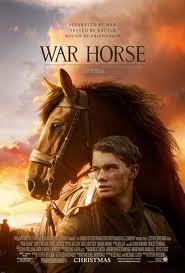
I went to see War Horse in the movies recently and got a few surprises. Firstly, I was under the impression that no one recognizable was in the cast. Imagine my surprise when I saw Benedict Cumberbatch on screen as Major Jamie Stewart who, by the way, is the antithesis of the Duke of Wellington as far as military strategy is concerned.
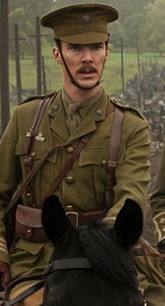
Tom Hiddleston, who first came to my notice in the 2001 version of Nicholas Nickleby, played Captain Nicholls in War Horse. He is the officer who first takes possession of Joey, or the War Horse, when he's intially sold to the Army. He vows to keep the horse safe and to return him at the end of the war.

Worth an honourable mention is Eddie Marsan as Sgt. Fry.

Another surprising thing about War Horse - I found myself crying at odd moments when no one else did. My first tear was shed at the opening when they showed wide shots of the hedgerows and fields of the English countryside. Next, I choked up when I saw the village in the scene where Joey is led away with the Army.
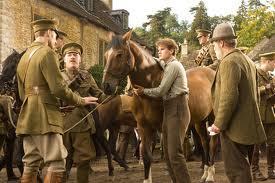
It was so iconically English. Turns out that the scene was shot in Water Street, Castle Combe, Wiltshire, below.

Then there was the scene where Cumberbatch and Hiddleston race for the gold ring during a practice charge. The entire regiment draws their swords and gallops forward, the ground thundering beneath them as thousands of hooves tear up the turf. It was so reminiscent of Waterloo that I couldn't help tearing up. Not that I was actually at Waterloo, mind you. Well, I was at Waterloo, but not during the battle. Well, okay, I was at Waterloo during a battle, but not during the Battle of Waterloo in 1815.
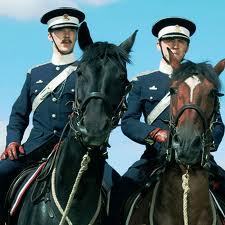
And then Benedict Cumberbatch, as Major Stewart, leads the regiment in their first battle charge in France, telling his men that their initial charge must at all costs be decisive, as it was at Waterloo, et al. And then, they begin their charge in field of wheat, a la Waterloo.
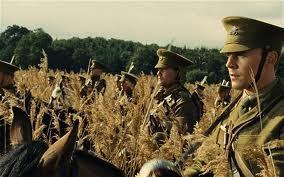
Oh, the humanity! As I choked out a sob, my husband said, "What are you crying for? Nothing's happened yet." Little did he know that it had happened. In 1815. In Belgium. In my mind. But the Wellington Connection was other than simply in my mind - it turns out that portions of War Horse were actually filmed at the Duke of Welllington's country home, Stratfield Saye, a fact pointed out to me by Jo Manning, who apparently sat through all the credits and noted that the producers thanked Lord and Lady Duoro for their cooperation in filming. Wikipedia tells us that "Filming of War Horse began with the cavalry scenes being filmed at Stratfield Saye House in north Hampshire, the estate of the Duke of Wellington, where incidentally Wellington's war horse "Copenhagen" is buried. Here a cavalry charge involving 130 extras was filmed."
So, there you have the Wellington Connection. For anything and everything else about War Horse, check Wikipedia here.[image error]
Published on January 09, 2012 23:54
January 8, 2012
Catching Up on 2011
Victoria, here. In the early days of 2012, I find myself sorting some books I acquired in the last year and some I still have to find, many of them concerned with Jane Austen. Gee, isn't that a shock!
Two are short story collections.
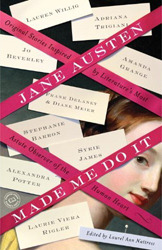
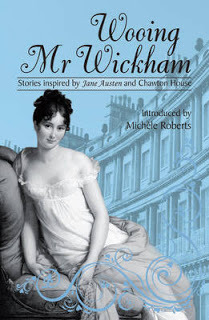
I enjoyed many of the stories in these two collections and admired the creative ways in which Jane
Austen inspired these writers. I recommend both.
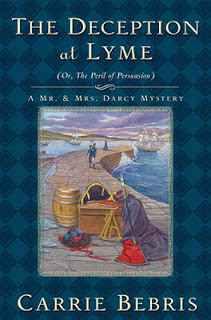
My friend and consummate author, Carrie Bebris, published Deception at Lyme, or The Peril of Persuasion, the sixth in her Mr and Mrs. Darcy mystery series. See her website here. Elizabeth and Darcy have solved a number of puzzles since their first outing in 2004's Pride and Prescience (or, A Truth Universally Acknowledged). And more are in the works.
Here is a book I haven't read yet, and have receive conflicting reports about: P.D. James version of Carrie's idea of having the Darcys investigate murder: Death Comes to Pemberley.
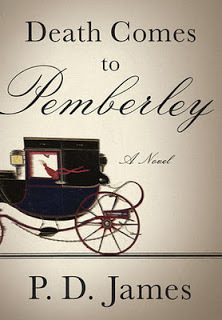
Of course, Baroness James gets a great deal of attention from the media, and no one can say she has not had a distinguished career. I have had many hours of delight from her books. But this one? Somehow, it smacks of jumping on the Austen bandwagon unnecessarily, but that could be unfair. I would love to hear from readers who have tried it out. I have a copy waiting for me next month, I think, when I get to the sunny south of Florida. I'll report back. (Note from Kristine: Yes, it's here waiting for you. I love James and so gave it a shot when Jo sent it to me. Unfortunately, I couldn't make it past Chapter Two).
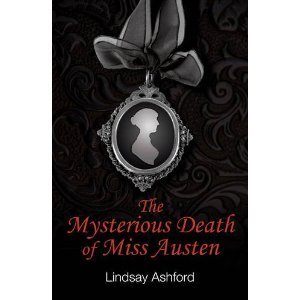
Another book I will read soon is The Mysterious Death of Miss Austen by Lindsay Ashford. I met Ms. Ashford at the JASNA-AGM in Fort Worth TX in October 2011, but I must have been extremely distracted since her authorship of this book, talked of widely at the AGM, escaped me when we met.
This book reportedly attributes the death of Jane Austen to arsenic poisoning. In one of those coincidences that seem to happen every so often, shortly after meeting Ms. Ashford, I attended a talk on poisons by Deborah Blum, a Pulitzer-Prize-winning science reporter who teaches journalism at the University of Wisconsin-Madison. She is the author of The Poisoner's Handbook, actually a catchy title for a history of forensic science in crime investigation.
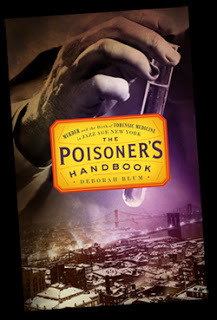
Ms. Blum commented on reviews of the Ashford book and the report that a lock of Jane Austen's hair showed evidence of arsenic when tested. Arsenic, in Austen's day, was a common ingredient of many lotions and potions used to whiten complexion and for dozens of other uses. It did not surprise Blum to learn of the possibility of Austen having arsenic in her system as she probably used arsenic-laced skin products.
I have heard several people say they enjoyed Mysterious Death, so I will read it soon. (Note from Kristine - this, too, is here waiting for you. Haven't read it yet - too distracted by Thirkell).
I haven't kept track of all the Austen sequels and continuations that came out recently -- and there are lots of them. I know some of the authors and they are all hard-working, devoted people -- success to all of you! For more information, take a look at the website of Austen Authors.
Two quite different but related genres to the sequels are the modern restructures of the novels and the JA-experience novels. I read two of those this year, perhaps not quite on top of their publication dates.
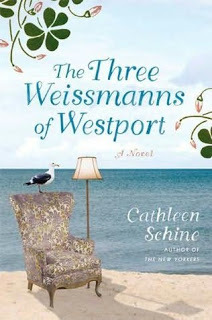
The Three Weissmanns of Westport came out in paperback, and I found it an engaging read, based loosely on the plot of Sense & Sensibility. It is well done.
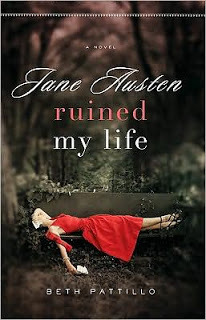
Beth Pattillo's Jane Austen Ruined My Life is also worth your time and energy. I resisted, because JA has done ANYTHING but ruined my life! She has provided great pleasure and stimulation, great companionship and friends, and a lifetime of interesting research topics related to her life and times. But a very well-respected friend loved it, and so did I. (Note from Kristine - I loved it, too!)
Finally, Stella Tillyard, author of The Aristocrats, Caroline, Emily, Louisa and Sarah Lennox, 1740-1832, published a novel of the Peninsular War this year, another entry on my TBR list.
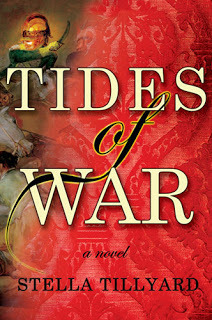
This is anything but an exhaustive list, but it looks like I'd better stop blogging and get reading if I am ever to catch up. Here's to a 2012 filled with wonderful books!
Two are short story collections.


I enjoyed many of the stories in these two collections and admired the creative ways in which Jane
Austen inspired these writers. I recommend both.

My friend and consummate author, Carrie Bebris, published Deception at Lyme, or The Peril of Persuasion, the sixth in her Mr and Mrs. Darcy mystery series. See her website here. Elizabeth and Darcy have solved a number of puzzles since their first outing in 2004's Pride and Prescience (or, A Truth Universally Acknowledged). And more are in the works.
Here is a book I haven't read yet, and have receive conflicting reports about: P.D. James version of Carrie's idea of having the Darcys investigate murder: Death Comes to Pemberley.

Of course, Baroness James gets a great deal of attention from the media, and no one can say she has not had a distinguished career. I have had many hours of delight from her books. But this one? Somehow, it smacks of jumping on the Austen bandwagon unnecessarily, but that could be unfair. I would love to hear from readers who have tried it out. I have a copy waiting for me next month, I think, when I get to the sunny south of Florida. I'll report back. (Note from Kristine: Yes, it's here waiting for you. I love James and so gave it a shot when Jo sent it to me. Unfortunately, I couldn't make it past Chapter Two).

Another book I will read soon is The Mysterious Death of Miss Austen by Lindsay Ashford. I met Ms. Ashford at the JASNA-AGM in Fort Worth TX in October 2011, but I must have been extremely distracted since her authorship of this book, talked of widely at the AGM, escaped me when we met.
This book reportedly attributes the death of Jane Austen to arsenic poisoning. In one of those coincidences that seem to happen every so often, shortly after meeting Ms. Ashford, I attended a talk on poisons by Deborah Blum, a Pulitzer-Prize-winning science reporter who teaches journalism at the University of Wisconsin-Madison. She is the author of The Poisoner's Handbook, actually a catchy title for a history of forensic science in crime investigation.

Ms. Blum commented on reviews of the Ashford book and the report that a lock of Jane Austen's hair showed evidence of arsenic when tested. Arsenic, in Austen's day, was a common ingredient of many lotions and potions used to whiten complexion and for dozens of other uses. It did not surprise Blum to learn of the possibility of Austen having arsenic in her system as she probably used arsenic-laced skin products.
I have heard several people say they enjoyed Mysterious Death, so I will read it soon. (Note from Kristine - this, too, is here waiting for you. Haven't read it yet - too distracted by Thirkell).
I haven't kept track of all the Austen sequels and continuations that came out recently -- and there are lots of them. I know some of the authors and they are all hard-working, devoted people -- success to all of you! For more information, take a look at the website of Austen Authors.
Two quite different but related genres to the sequels are the modern restructures of the novels and the JA-experience novels. I read two of those this year, perhaps not quite on top of their publication dates.

The Three Weissmanns of Westport came out in paperback, and I found it an engaging read, based loosely on the plot of Sense & Sensibility. It is well done.

Beth Pattillo's Jane Austen Ruined My Life is also worth your time and energy. I resisted, because JA has done ANYTHING but ruined my life! She has provided great pleasure and stimulation, great companionship and friends, and a lifetime of interesting research topics related to her life and times. But a very well-respected friend loved it, and so did I. (Note from Kristine - I loved it, too!)
Finally, Stella Tillyard, author of The Aristocrats, Caroline, Emily, Louisa and Sarah Lennox, 1740-1832, published a novel of the Peninsular War this year, another entry on my TBR list.

This is anything but an exhaustive list, but it looks like I'd better stop blogging and get reading if I am ever to catch up. Here's to a 2012 filled with wonderful books!
Published on January 08, 2012 01:00
January 6, 2012
First Transatlantic Telephone Call
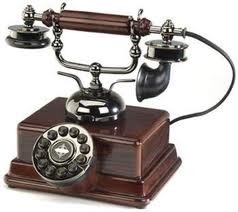
It took 50 years from the invention of the telephone to make transatlantic phone calls possible, as there was much more than the mere laying of a cable to achieve the feat, since the voltages involved in telephone calls were too low to be passed though such a long cable and there was no known technology for underwater repeater amplifiers. It wasn't until the wireless was invented that across the pond communication became possible. Bell System engineers achieved the first voice transmission across the Atlantic, connecting Virginia and Paris briefly in 1915. A year later they held the first two-way conversation with a ship at sea. However, these were just experimental demonstrations and it wasn't until 7 March 1926 that the first transatlantic telephone call, from London to New York, was completed. The first commercial telephone service, using radio, began on January 7, 1927, between New York and London. The initial capacity was one call at a time at a cost of $75 for the first three minutes.
Published on January 06, 2012 01:01
January 4, 2012
Harlaxton Manor
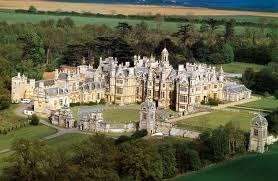
From The Greville Memoirs
January 4 1838
"To-day we went to see the house Mr. Gregory is building, five miles from here. He is a gentleman of about 12,000 pounds. a year, who has a fancy to build a magnificent house in the Elizabethan style, and he is now in the middle of his work, all the shell being finished except one wing. Nothing can be more perfect than it is, both as to the architecture and the ornaments; but it stands on the slope of a hill upon a deep clay soil, with no park around it, very little wood, and scarcely any fine trees. Many years ago, when he first conceived this design, he began to amass money and lived for no other object. He travelled into all parts of Europe collecting objects of curiosity, useful or ornamental, for his projected palace, and he did not begin to build until he had accumulated money enough to complete his design. The grandeur of it is such, and such the tardiness of its progress, that it is about as much as he will do to live till its completion; and as he is not married, has no children, and dislikes the heir on whom his property is entailed, it is the means and not the end to which he looks for gratification. He says that it is his amusement, as hunting or shooting or feasting may be the objects of other people; and as the pursuit leads him into all parts of the world, and to mix with every variety of nation and character, besides engendering tastes pregnant with instruction and curious research, it is not irrational, although he should never inhabit his house, and may be toiling and saving for the benefit of persons he cares nothing about. The cottages round Harlaxton are worth seeing. It has been his fancy to build a whole village in all sorts of strange fantastic styles. There are Dutch and Swiss cottages, every variety of old English, and heaps of nondescript things, which appear only to have been built for variety's sake. The effect is extremely pretty. Close to the village is an old manor house, the most perfect specimen I ever saw of such a building, the habitation of an English country gentleman of former times, and there were a buff jerkin and a pair of jack boots hanging up in the hall, which the stout old Cavalier of the seventeenth century (and one feels sure that the owner of that house was a Cavalier) had very likely worn at Marston Moor or Naseby."
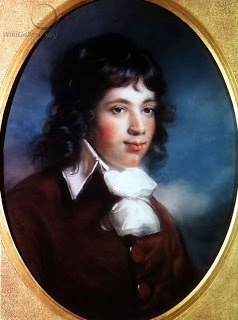 Delignes Gregory of Harlaxton Manor
Delignes Gregory of Harlaxton Manor Copyright Wiki Gallery
To read more about the Harlaxton cottages and gardens,
Published on January 04, 2012 00:49
January 2, 2012
Coutts Bank, a London Institution
Victoria, here, dreaming about my weeks in England last spring. Here are my photos of Coutts Bank, The Strand, London, taken in June 2011. The bank's website is here.
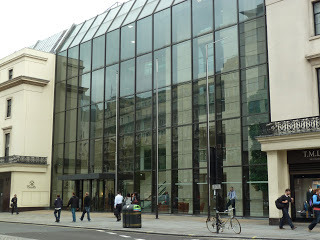
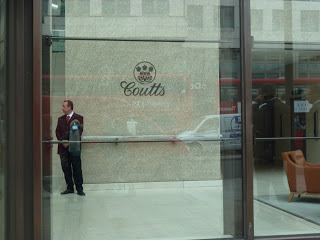
It looks like an important place, though the architecture is about as 1970's Mundane as one could imagine. The only reason I actually noticed it was that I was often across the street, sitting in McDonald's where I could use their free wi-fi to power my iPad.* I was particularly amused that this great London institution, the bank that holds accounts for Her Majesty the Queen, had a glass curtain wall that clearly reflected that notable American institution on the other side!
[*Why is is that really inexpensive hotels have free wi-fi service while the better establishments charge outrageous amounts for the same thing? ]
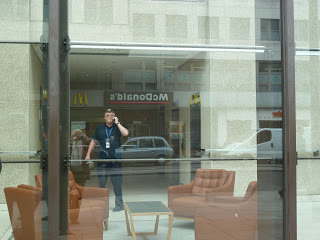 As I walked closer to get this picture of the reflection of McDonald's, I think that guard inside picked up the phone to call for assistance to deal with the clearly deranged photographer on the pavement! I didn't wait around to see what happened! I'll bet the bank's directors did not consider what might happen to the glass during major demonstrations moving towards the adjacent Trafalgar Square. You can clearly see the McDonald's sign reflected above and to the right of his head.
As I walked closer to get this picture of the reflection of McDonald's, I think that guard inside picked up the phone to call for assistance to deal with the clearly deranged photographer on the pavement! I didn't wait around to see what happened! I'll bet the bank's directors did not consider what might happen to the glass during major demonstrations moving towards the adjacent Trafalgar Square. You can clearly see the McDonald's sign reflected above and to the right of his head.
So, fully knowing I was edging into Wellington Connection territory, I decided to see what more I could learn about Coutts Bank. Angela Coutts (1814-1906) was a dear friend of the 1st Duke of Wellington, one of those younger women so attracted to the Great Hero (*like many of us???). But there must be much more. The bank's website has a nice timeline and lots of information, but other than the widely known fact that QEII banks there, the list of clients is a well-protected secret.
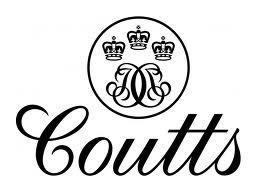
It is said that checks written by (for?) the Queen are often saved as souvenirs, making it difficult to balance her accounts.
Here is an account of a famous period in the existence of the bank, excerpted from Tales of the Bank of England, with anecdotes of London bankers, an anonymous book from 1882:
"The house of Coutts & Co. has a very interesting history. A very great banking heiress is the Baroness Burdett-Coutts, whose recent marriage with Mr. Ashmead Coutts-Bartlett excited so much attention. The kindly and popular Baroness is—or was until recently—the head of the great banking firm of Coutts & Co., and was popularly supposed to draw a hundred thousand a year from the business. Mr. Coutts married, for his second wife, Miss Mellon, the actress, to whom he left his entire fortune—about a million of money. Mrs. Coutts, left a widow, married the Duke of St. Albans; but, in her marriage settlement, this vast fortune was left entirely in her own power. She thought that she would best carry out the wishes of her husband, who had made the money, by bequeathing it to his favourite granddaughter, Miss Angela Burdett, the daughter of the famous Sir Francis. An infinite amount of this money "has wandered Heaven-directed, to the poor." Child's Bank was once represented by a lady, who became Countess of Westmoreland, and afterwards by her daughter, who became Countess of Jersey. On certain state occasions Lady Jersey dined with the bank officials, and took the head of the table.
The history of Coutt's Bank shows how much may be done by a discriminating liberality. Old Coutts heard, one day at a dinner-party, from the manager of a city bank, that a nobleman had applied to his house for the loan of thirty thousand pounds, and had been refused. At ten o'clock at night he started for the peer's house, and saw his steward. He explained his business, and said that if the nobleman would call upon him the next morning, he might have whatever he wanted. On the next morning, when the noble lord called at the bank, Mr. Coutts handed him thirty notes of a thousand pounds each. "What security do you want?" asked the peer. "I shall be satisfied with your note-of hand," was the reply. This was given; and the nobleman said, " I shall only want for the present ten thousand pounds of the money; so I will leave twenty thousand pounds with you, and open an account." Some time afterwards the nobleman sold an estate for two hundred thousand pounds, which he deposited with Coutts's. Nor was this all. He told the anecdote to his friends, and also to George III. The King was so impressed with the story that he himself deposited a large sum with Mr. Coutts. The King withdrew his patronage, however, when Coutts supported Sir Francis Burdett in his contest for Middlesex with immense sums, and transferred his account to another banker, who failed; and we cannot help thinking that in this instance his Majesty was served quite right."
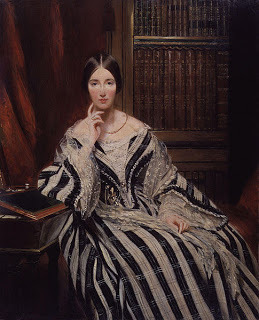 Angela Burdett-Coutts, portrait by an unknown artist, from the National Portrait Gallery
Angela Burdett-Coutts, portrait by an unknown artist, from the National Portrait Gallery
Another old excerpt about the bank appears in Walter Thornbury's 1865 volume Haunted London (this obviously refers to the old headquarters of the bank on The Strand, not the present building pictured above):
"No. 59 is Coutts's Bank. It was built by the Adam brothers—to whom we are indebted for the Adelphi—for Mr. Coutts, in 1768. The old house of the firm, of the date of Queen Anne, was situated in St. Martin's-lane. No. 59 contains some fine marble chimney-pieces of the Cipriani and Bacon school. The dining-room is hung with quaint Chinese subjects on paper, sent to Coutts by Lord Macartney, while on his embassy to China, in 1792-95. In another room hang portraits of some early friends of this son of Mammon, including Dr. Armstrong, the poet and physician, Fuseli's friend, by Reynolds. Mr. Coutts was the son of a Dundee merchant. His first wife was a servant, a Lancashire labourer's offspring. He had three daughters, one of whom became the wife of Sir Francis Burdett, a second Countess of Guilford, and a third Marchioness of Bute. On becoming acquainted with Miss Mellon, and inducing her to leave the stage to avoid perpetual insults, Mr. Coutts bought for her a small villa of Sir W. Vane Tempest, called Holly Lodge, at the foot of Highgate Hill, for which he gave 25,000/. His banking-house strong rooms alone cost 10,000/. building. The first deposit in the enlarged house was the diamond aigrette that the Grand Signor had placed in Sir Horatio Nelson's hat. Mr. Coutts, though very charitable, was precise and exact. On one occasion, there being a deficit of 2s. li)d. in the day's accounts, the clerks were detained for hours, or, as I believe, all night. One of Coutts's clerks, who took the western walk, was discovered to be missing with 17,000/.* Rewards were offered, and the town placarded, but all in vain. The next day, however, the note-case arrived from Southampton. The clerk's story was, that on his way through Piccadilly, being seized with a stupor, he had got into a coach in order to secure the money. He had remained insensible the whole journey, and had awoke at Southampton. Mr. Coutts gave him a handsome sum from his private purse, but dismissed him.Coutts's Bank stands on nearly the centre of the site of the New Exchange. When the Adelphi was built in Durham Gardens, Mr. Coutts purchased a vista to prevent his view being interrupted, stipulating that the new street leading to the entrance should face this opening; and on this space, up to the level of the Strand, he built his strong rooms. Some years after, wishing to enlarge them, he erected over the office a counting-house and set of offices, extending from William-street to Robert-street, and threw a stone bridge over William-street to connect the front and back premises. Mr. Coutts, a few years before his death, married Harriet Mellon, who, after his death, became the wife of the Duke of St. Albans, a descendant of Nell Gwynn, that light-hearted wanton, whom nobody could hate. "Miss Mellon," says Leigh Hunt, "was arch and agreeable on the stage; she had no genius; but then she had fine eyes and a goodhumoured mouth." The same gay writer describes her when young as bustling about at sea-ports, selling tickets for her benefit-night; but then, says the kindly apologist for everybody, she had been left with a mother to support."
I wish that old building was still the headquarters. And I suspect that you will hear more about Angela Burdett-Coutts in this space in the future.
In 1969 Coutt's Bank, with origins in the late 17th century, was bought by National Westminster Bank (NatWest), and in 2000, NatWest was purchased by the Royal Bank of Scotland. Coutt's is now the wealth division of the conglomerate, engaged in private banking, with branches and offices worldwide. To become their client, I assume you would have to rob your piggy bank. And a few others as well.
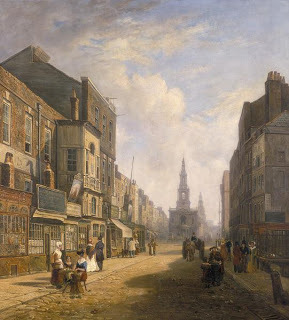 The Strand, c. 1824
The Strand, c. 1824



It looks like an important place, though the architecture is about as 1970's Mundane as one could imagine. The only reason I actually noticed it was that I was often across the street, sitting in McDonald's where I could use their free wi-fi to power my iPad.* I was particularly amused that this great London institution, the bank that holds accounts for Her Majesty the Queen, had a glass curtain wall that clearly reflected that notable American institution on the other side!
[*Why is is that really inexpensive hotels have free wi-fi service while the better establishments charge outrageous amounts for the same thing? ]
 As I walked closer to get this picture of the reflection of McDonald's, I think that guard inside picked up the phone to call for assistance to deal with the clearly deranged photographer on the pavement! I didn't wait around to see what happened! I'll bet the bank's directors did not consider what might happen to the glass during major demonstrations moving towards the adjacent Trafalgar Square. You can clearly see the McDonald's sign reflected above and to the right of his head.
As I walked closer to get this picture of the reflection of McDonald's, I think that guard inside picked up the phone to call for assistance to deal with the clearly deranged photographer on the pavement! I didn't wait around to see what happened! I'll bet the bank's directors did not consider what might happen to the glass during major demonstrations moving towards the adjacent Trafalgar Square. You can clearly see the McDonald's sign reflected above and to the right of his head.So, fully knowing I was edging into Wellington Connection territory, I decided to see what more I could learn about Coutts Bank. Angela Coutts (1814-1906) was a dear friend of the 1st Duke of Wellington, one of those younger women so attracted to the Great Hero (*like many of us???). But there must be much more. The bank's website has a nice timeline and lots of information, but other than the widely known fact that QEII banks there, the list of clients is a well-protected secret.

It is said that checks written by (for?) the Queen are often saved as souvenirs, making it difficult to balance her accounts.
Here is an account of a famous period in the existence of the bank, excerpted from Tales of the Bank of England, with anecdotes of London bankers, an anonymous book from 1882:
"The house of Coutts & Co. has a very interesting history. A very great banking heiress is the Baroness Burdett-Coutts, whose recent marriage with Mr. Ashmead Coutts-Bartlett excited so much attention. The kindly and popular Baroness is—or was until recently—the head of the great banking firm of Coutts & Co., and was popularly supposed to draw a hundred thousand a year from the business. Mr. Coutts married, for his second wife, Miss Mellon, the actress, to whom he left his entire fortune—about a million of money. Mrs. Coutts, left a widow, married the Duke of St. Albans; but, in her marriage settlement, this vast fortune was left entirely in her own power. She thought that she would best carry out the wishes of her husband, who had made the money, by bequeathing it to his favourite granddaughter, Miss Angela Burdett, the daughter of the famous Sir Francis. An infinite amount of this money "has wandered Heaven-directed, to the poor." Child's Bank was once represented by a lady, who became Countess of Westmoreland, and afterwards by her daughter, who became Countess of Jersey. On certain state occasions Lady Jersey dined with the bank officials, and took the head of the table.
The history of Coutt's Bank shows how much may be done by a discriminating liberality. Old Coutts heard, one day at a dinner-party, from the manager of a city bank, that a nobleman had applied to his house for the loan of thirty thousand pounds, and had been refused. At ten o'clock at night he started for the peer's house, and saw his steward. He explained his business, and said that if the nobleman would call upon him the next morning, he might have whatever he wanted. On the next morning, when the noble lord called at the bank, Mr. Coutts handed him thirty notes of a thousand pounds each. "What security do you want?" asked the peer. "I shall be satisfied with your note-of hand," was the reply. This was given; and the nobleman said, " I shall only want for the present ten thousand pounds of the money; so I will leave twenty thousand pounds with you, and open an account." Some time afterwards the nobleman sold an estate for two hundred thousand pounds, which he deposited with Coutts's. Nor was this all. He told the anecdote to his friends, and also to George III. The King was so impressed with the story that he himself deposited a large sum with Mr. Coutts. The King withdrew his patronage, however, when Coutts supported Sir Francis Burdett in his contest for Middlesex with immense sums, and transferred his account to another banker, who failed; and we cannot help thinking that in this instance his Majesty was served quite right."
 Angela Burdett-Coutts, portrait by an unknown artist, from the National Portrait Gallery
Angela Burdett-Coutts, portrait by an unknown artist, from the National Portrait Gallery Another old excerpt about the bank appears in Walter Thornbury's 1865 volume Haunted London (this obviously refers to the old headquarters of the bank on The Strand, not the present building pictured above):
"No. 59 is Coutts's Bank. It was built by the Adam brothers—to whom we are indebted for the Adelphi—for Mr. Coutts, in 1768. The old house of the firm, of the date of Queen Anne, was situated in St. Martin's-lane. No. 59 contains some fine marble chimney-pieces of the Cipriani and Bacon school. The dining-room is hung with quaint Chinese subjects on paper, sent to Coutts by Lord Macartney, while on his embassy to China, in 1792-95. In another room hang portraits of some early friends of this son of Mammon, including Dr. Armstrong, the poet and physician, Fuseli's friend, by Reynolds. Mr. Coutts was the son of a Dundee merchant. His first wife was a servant, a Lancashire labourer's offspring. He had three daughters, one of whom became the wife of Sir Francis Burdett, a second Countess of Guilford, and a third Marchioness of Bute. On becoming acquainted with Miss Mellon, and inducing her to leave the stage to avoid perpetual insults, Mr. Coutts bought for her a small villa of Sir W. Vane Tempest, called Holly Lodge, at the foot of Highgate Hill, for which he gave 25,000/. His banking-house strong rooms alone cost 10,000/. building. The first deposit in the enlarged house was the diamond aigrette that the Grand Signor had placed in Sir Horatio Nelson's hat. Mr. Coutts, though very charitable, was precise and exact. On one occasion, there being a deficit of 2s. li)d. in the day's accounts, the clerks were detained for hours, or, as I believe, all night. One of Coutts's clerks, who took the western walk, was discovered to be missing with 17,000/.* Rewards were offered, and the town placarded, but all in vain. The next day, however, the note-case arrived from Southampton. The clerk's story was, that on his way through Piccadilly, being seized with a stupor, he had got into a coach in order to secure the money. He had remained insensible the whole journey, and had awoke at Southampton. Mr. Coutts gave him a handsome sum from his private purse, but dismissed him.Coutts's Bank stands on nearly the centre of the site of the New Exchange. When the Adelphi was built in Durham Gardens, Mr. Coutts purchased a vista to prevent his view being interrupted, stipulating that the new street leading to the entrance should face this opening; and on this space, up to the level of the Strand, he built his strong rooms. Some years after, wishing to enlarge them, he erected over the office a counting-house and set of offices, extending from William-street to Robert-street, and threw a stone bridge over William-street to connect the front and back premises. Mr. Coutts, a few years before his death, married Harriet Mellon, who, after his death, became the wife of the Duke of St. Albans, a descendant of Nell Gwynn, that light-hearted wanton, whom nobody could hate. "Miss Mellon," says Leigh Hunt, "was arch and agreeable on the stage; she had no genius; but then she had fine eyes and a goodhumoured mouth." The same gay writer describes her when young as bustling about at sea-ports, selling tickets for her benefit-night; but then, says the kindly apologist for everybody, she had been left with a mother to support."
I wish that old building was still the headquarters. And I suspect that you will hear more about Angela Burdett-Coutts in this space in the future.
In 1969 Coutt's Bank, with origins in the late 17th century, was bought by National Westminster Bank (NatWest), and in 2000, NatWest was purchased by the Royal Bank of Scotland. Coutt's is now the wealth division of the conglomerate, engaged in private banking, with branches and offices worldwide. To become their client, I assume you would have to rob your piggy bank. And a few others as well.
 The Strand, c. 1824
The Strand, c. 1824
Published on January 02, 2012 01:00
December 31, 2011
Speaking of Bridget Jones . . . .
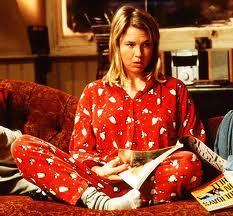
Happy New Year! We can't think of anything more fitting than watching this video as we ring in the New Year. If you'll be spending the New Year with friends, it'll get you into the party spirit and if you'll be celebrating alone, it will give you hope - things eventually turned out well for Bridget . . . didn't they? Watch the video here.
Published on December 31, 2011 00:49
December 30, 2011
Prepare for The Year of Dickens
2012 brings the 200th Birthday of Charles Dickens (1812-1870), the man who shaped our perception of Victorian England in his thousands of pages of delicious stories -- not to mention his reporting and essays.
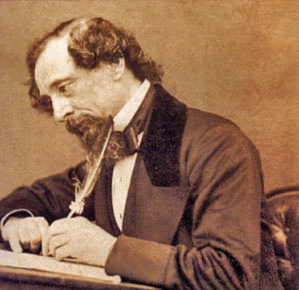 Dickens in 1858
Dickens in 1858
Charles Dickens was born in 1812. His somewhat feckless parents caused him to have an alternately comfortable and difficult life as a child, including a stint working in a London blacking factory, where he experienced first hand the travails of the poor working class he so vividly portrayed in his stories.
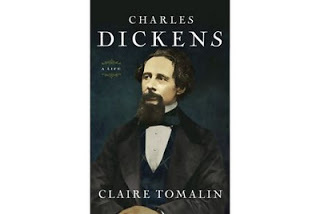
Santa favored me with a copy of Claire Tomalin's biography of Dickens, a book that was on many "best" lists for 2011 and which received many glowing reviews. Tomalin had already done considerable work on Dickens and his secret life. Her book, Invisible Woman, was published in 1991, telling of his 13-year affair with Ellen Ternan at the end of his life. He had previously married the boss's daughter (or one of his bosses), Catherine Hogarth, whose father was the editor of the Evening Chronicle, for which Dickens wrote. They had ten children, but grew apart.
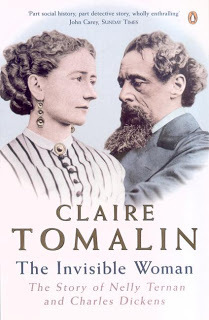
Claire Tomalin is an excellent biographer. She has published the life stories of many famous writers, such as Katherine Mansfield (1989), Pepys (2003), and Thomas Hardy (2007). She has written about others, as well, particularly - from my bookshelf -- Mrs. Jordan's Profession (1994) -- the story of London actress Dorothea Jordan (1761-1816) and her long affair with Prince William, Duke of Clarence (1765-1837), with whom Dora had ten children. He later succeeded his brother to become William IV, King of England 1830-1837.
 Claire TomalinI suppose it will come as no surprise to occasional readers of this blog to learn that my favorite biography of Tomalin's is her Jane Austen: A Life, an excellent study of the artist whose work is the source-point for all my interests in the long 18th Century, the Regency, the Georgians, the Victorians, and all things English/British.
Claire TomalinI suppose it will come as no surprise to occasional readers of this blog to learn that my favorite biography of Tomalin's is her Jane Austen: A Life, an excellent study of the artist whose work is the source-point for all my interests in the long 18th Century, the Regency, the Georgians, the Victorians, and all things English/British.
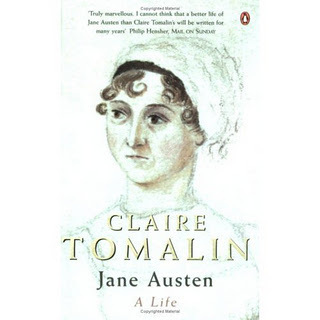
But I digress... you will find no shortage of biographies and studies of the work of Charles Dickens in the upcoming months. Plays, movies, television programs -- he will be everywhere. We have just had, in many US cities and elsewhere, the traditional holiday season performances of A Christmas Carol, which one cannot see too many times, or so it seems to me.
Ebenezer Scrooge is only one of the hundreds of characters Dickens create which stay in our memories forever. Who could ever forget the Artful Dodger? Or Miss Havisham? Or Mr. Micawber or Uriah Heep? You can name dozens more, no doubt.
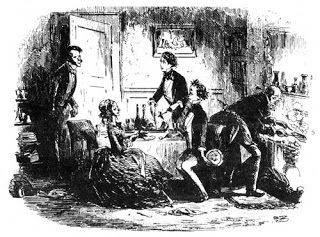 David Copperfield illustration
David Copperfield illustration
David Copperfield is said to be somewhat biographical.
Dickens began publishing stories in 1833 when he was just 21 years old. He generally published his stories in magazines, in serial form, meaning that every few pages, there is a suspenseful moment, designed to bring the reader back next month to buy the next installment. This method enhances the page-turner quality of all of his novels. He was immensely popular in his day, engaging in many public readings around Britain as well as during two trips to the U.S.
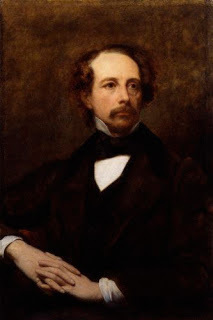 Charles Dickens by Ary Scheffer, 1855; NPG, LondonSo in the next 12 months (and beyond), be self-indulgent, and read some of the long and enjoyable works of Charles Dickens. It is a pleasure you owe yourself![image error]
Charles Dickens by Ary Scheffer, 1855; NPG, LondonSo in the next 12 months (and beyond), be self-indulgent, and read some of the long and enjoyable works of Charles Dickens. It is a pleasure you owe yourself![image error]
 Dickens in 1858
Dickens in 1858Charles Dickens was born in 1812. His somewhat feckless parents caused him to have an alternately comfortable and difficult life as a child, including a stint working in a London blacking factory, where he experienced first hand the travails of the poor working class he so vividly portrayed in his stories.

Santa favored me with a copy of Claire Tomalin's biography of Dickens, a book that was on many "best" lists for 2011 and which received many glowing reviews. Tomalin had already done considerable work on Dickens and his secret life. Her book, Invisible Woman, was published in 1991, telling of his 13-year affair with Ellen Ternan at the end of his life. He had previously married the boss's daughter (or one of his bosses), Catherine Hogarth, whose father was the editor of the Evening Chronicle, for which Dickens wrote. They had ten children, but grew apart.

Claire Tomalin is an excellent biographer. She has published the life stories of many famous writers, such as Katherine Mansfield (1989), Pepys (2003), and Thomas Hardy (2007). She has written about others, as well, particularly - from my bookshelf -- Mrs. Jordan's Profession (1994) -- the story of London actress Dorothea Jordan (1761-1816) and her long affair with Prince William, Duke of Clarence (1765-1837), with whom Dora had ten children. He later succeeded his brother to become William IV, King of England 1830-1837.
 Claire TomalinI suppose it will come as no surprise to occasional readers of this blog to learn that my favorite biography of Tomalin's is her Jane Austen: A Life, an excellent study of the artist whose work is the source-point for all my interests in the long 18th Century, the Regency, the Georgians, the Victorians, and all things English/British.
Claire TomalinI suppose it will come as no surprise to occasional readers of this blog to learn that my favorite biography of Tomalin's is her Jane Austen: A Life, an excellent study of the artist whose work is the source-point for all my interests in the long 18th Century, the Regency, the Georgians, the Victorians, and all things English/British.
But I digress... you will find no shortage of biographies and studies of the work of Charles Dickens in the upcoming months. Plays, movies, television programs -- he will be everywhere. We have just had, in many US cities and elsewhere, the traditional holiday season performances of A Christmas Carol, which one cannot see too many times, or so it seems to me.
Ebenezer Scrooge is only one of the hundreds of characters Dickens create which stay in our memories forever. Who could ever forget the Artful Dodger? Or Miss Havisham? Or Mr. Micawber or Uriah Heep? You can name dozens more, no doubt.
 David Copperfield illustration
David Copperfield illustrationDavid Copperfield is said to be somewhat biographical.
Dickens began publishing stories in 1833 when he was just 21 years old. He generally published his stories in magazines, in serial form, meaning that every few pages, there is a suspenseful moment, designed to bring the reader back next month to buy the next installment. This method enhances the page-turner quality of all of his novels. He was immensely popular in his day, engaging in many public readings around Britain as well as during two trips to the U.S.
 Charles Dickens by Ary Scheffer, 1855; NPG, LondonSo in the next 12 months (and beyond), be self-indulgent, and read some of the long and enjoyable works of Charles Dickens. It is a pleasure you owe yourself![image error]
Charles Dickens by Ary Scheffer, 1855; NPG, LondonSo in the next 12 months (and beyond), be self-indulgent, and read some of the long and enjoyable works of Charles Dickens. It is a pleasure you owe yourself![image error]
Published on December 30, 2011 01:00
December 28, 2011
The Queen's Diamond Jubilee in 2012
Great Britain and the world will celebrate Queen Elizabeth's sixty-year reign in 2012. We can't wait!
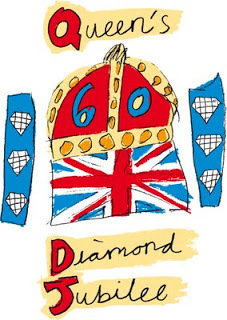
The logo was chosen from 35,000 entries in a contest sponsored by the BBC. Katherine Dewar, of Chester, age ten, is the talented artist.
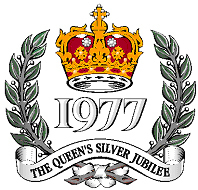
The Queen's Silver Jubilee was celebrated in 1977.
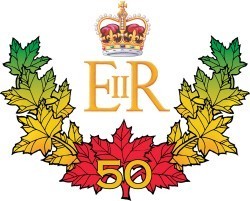
The Golden Jubilee, marking Queen Elizabeth's fifty years on the throne, was celebrated in 2002. One of the fun events was a grand concert in the Garden of Buckingham Palace -- broadcast all over the world. I imagine we will see some of the same kind of spectacles next summer around the official weekend on June, 2012.

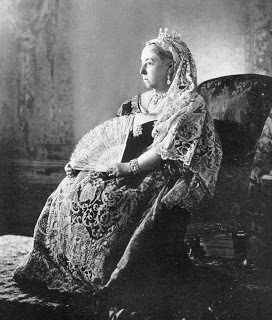 Queen Victoria celebrated her Diamond Jubilee in 1897. Above is her official picture from the celebration. She became Queen of England on the death of her uncle, William IV, in 1837, when she was age 18. She died in January, 1901, after a reign of 63 years and 7 months, longest ever for an English monarch.
Queen Victoria celebrated her Diamond Jubilee in 1897. Above is her official picture from the celebration. She became Queen of England on the death of her uncle, William IV, in 1837, when she was age 18. She died in January, 1901, after a reign of 63 years and 7 months, longest ever for an English monarch.
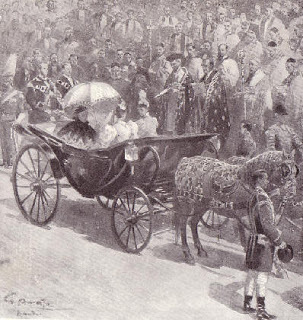
Victoria's 1897 Diamond Jubilee was marked by nationwide celebrations, a gathering of the world's reigning monarchs and local festivities, setting the precedents for 2012.
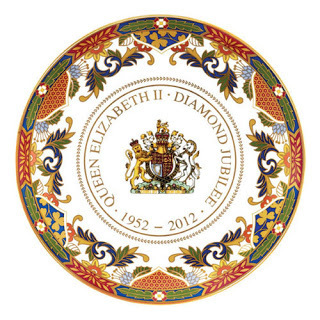 Above is a commemorative plate, just one of many souvenirs available. For the very finest quality items, I suggest contacting the Royal collection gift shop here. Think of how valuable it might become, though a quick google search for commemoratives from Victoria's Jubilee turns up several examples for less than $200, as below.
Above is a commemorative plate, just one of many souvenirs available. For the very finest quality items, I suggest contacting the Royal collection gift shop here. Think of how valuable it might become, though a quick google search for commemoratives from Victoria's Jubilee turns up several examples for less than $200, as below.
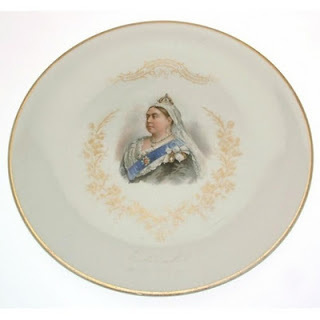
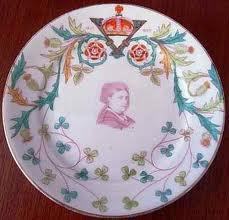
If you aren't in a collecting mood so soon after Christmas, you could spend hours surfing the sites devoted to the 2012 jubilee.
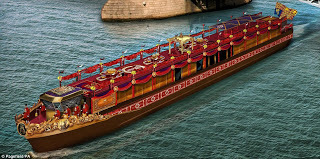
Here is the official site, soon to be updated. Above is the jubilee barge, to be used on the Thames during the official weekend of celebrations, beginning June 3, 2012. For more info on the barge, go to the BBC News.
Longer runs will be held for the exhibitions at royal residences. More Information is here. Special exhibitions will be on view at Windsor Castle, Buckingham Palace and the Palace of Holyroodhouse, as well as special showings of the Royal Collections's drawings by Leonardo da Vinci in England, Scotland and Northern Ireland. Below, Head of Leda, from the Royal Collection, by Leonardo da Vinci, c. 1505-06, probably acquired by Charles II.
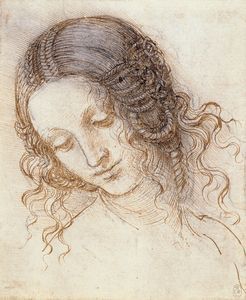
Lest we forget what the Diamond Jubilee is celebrating, here are a few pictures of the Queen during her reign.
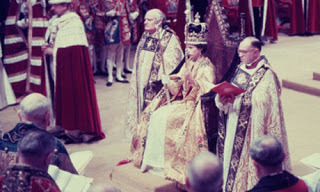
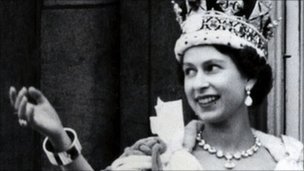
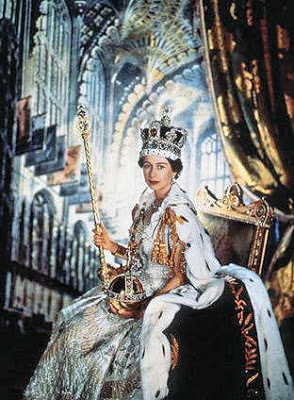
above, 1952; below, 1977.
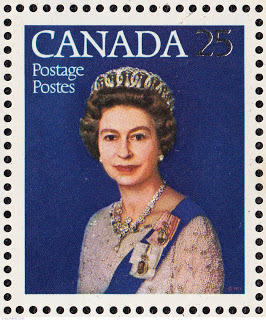
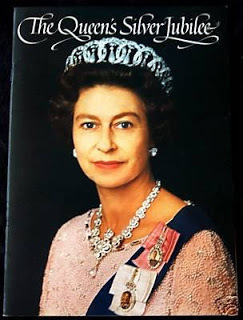
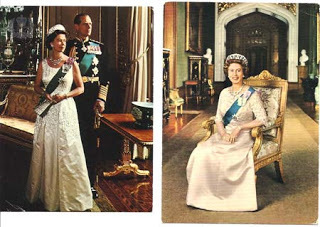
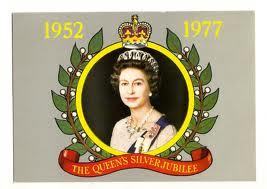

Above, Andy Warhol's take on her Majesty. Below, Elizabeth II's "Golden Jubilee" in 2002.
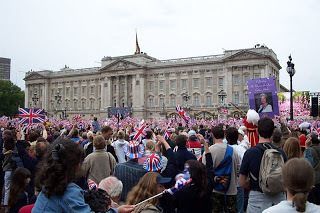
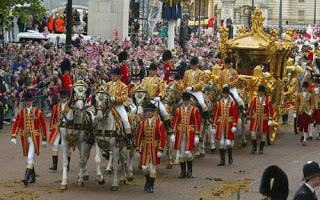
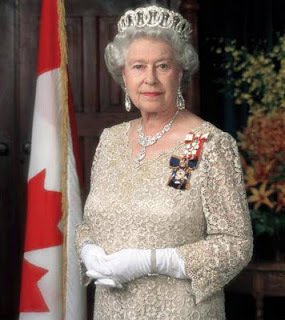
Here are some more recent photos of the the Queen in 2011:
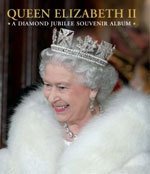

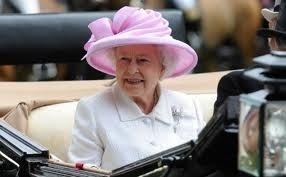
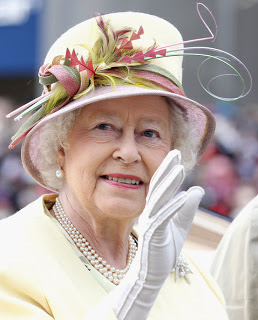
My choice for the prettiest hat ever is the pink one, worn last June at Ascot. May she reign on (and keep the hatmakers happy)!! Stay tuned for more Diamond Jubilee stories.[image error]

The logo was chosen from 35,000 entries in a contest sponsored by the BBC. Katherine Dewar, of Chester, age ten, is the talented artist.

The Queen's Silver Jubilee was celebrated in 1977.

The Golden Jubilee, marking Queen Elizabeth's fifty years on the throne, was celebrated in 2002. One of the fun events was a grand concert in the Garden of Buckingham Palace -- broadcast all over the world. I imagine we will see some of the same kind of spectacles next summer around the official weekend on June, 2012.

 Queen Victoria celebrated her Diamond Jubilee in 1897. Above is her official picture from the celebration. She became Queen of England on the death of her uncle, William IV, in 1837, when she was age 18. She died in January, 1901, after a reign of 63 years and 7 months, longest ever for an English monarch.
Queen Victoria celebrated her Diamond Jubilee in 1897. Above is her official picture from the celebration. She became Queen of England on the death of her uncle, William IV, in 1837, when she was age 18. She died in January, 1901, after a reign of 63 years and 7 months, longest ever for an English monarch. 
Victoria's 1897 Diamond Jubilee was marked by nationwide celebrations, a gathering of the world's reigning monarchs and local festivities, setting the precedents for 2012.
 Above is a commemorative plate, just one of many souvenirs available. For the very finest quality items, I suggest contacting the Royal collection gift shop here. Think of how valuable it might become, though a quick google search for commemoratives from Victoria's Jubilee turns up several examples for less than $200, as below.
Above is a commemorative plate, just one of many souvenirs available. For the very finest quality items, I suggest contacting the Royal collection gift shop here. Think of how valuable it might become, though a quick google search for commemoratives from Victoria's Jubilee turns up several examples for less than $200, as below.

If you aren't in a collecting mood so soon after Christmas, you could spend hours surfing the sites devoted to the 2012 jubilee.

Here is the official site, soon to be updated. Above is the jubilee barge, to be used on the Thames during the official weekend of celebrations, beginning June 3, 2012. For more info on the barge, go to the BBC News.
Longer runs will be held for the exhibitions at royal residences. More Information is here. Special exhibitions will be on view at Windsor Castle, Buckingham Palace and the Palace of Holyroodhouse, as well as special showings of the Royal Collections's drawings by Leonardo da Vinci in England, Scotland and Northern Ireland. Below, Head of Leda, from the Royal Collection, by Leonardo da Vinci, c. 1505-06, probably acquired by Charles II.

Lest we forget what the Diamond Jubilee is celebrating, here are a few pictures of the Queen during her reign.



above, 1952; below, 1977.





Above, Andy Warhol's take on her Majesty. Below, Elizabeth II's "Golden Jubilee" in 2002.



Here are some more recent photos of the the Queen in 2011:




My choice for the prettiest hat ever is the pink one, worn last June at Ascot. May she reign on (and keep the hatmakers happy)!! Stay tuned for more Diamond Jubilee stories.[image error]
Published on December 28, 2011 01:00
December 26, 2011
Boxing Day

From The book of Christmas: descriptive of the customs, ceremonies, traditions ... By Thomas Kibble Hervey (1845)
This day—which, in our calendar, is still dedicated to the first Christian martyr, St. Stephen (for John the Baptist perished in the same cause, before the consummation of the old law, and the full introduction of the Christian dispensation),—is more popularly known by the title of Boxing-day; and its importance, amongst the Christmas festivities, is derived from the practice whence that title comes.
We have already mentioned that the custom of bestowing gifts, at seasons of joyous commemoration, has been a form of thankfulness at most periods;—and that it may have been directly borrowed, by the Christian worshippers, from the Polytheists of Rome, along with those other modes of celebration which descended to the Christmas festival, from that source,—introduced, however, amongst our own observances, under scripture sanctions, drawn both from the Old and New Testaments. The particular form of that practice, whose donations are known by the title of Christmas-boxes (and which appear to differ from New-year's gifts in this,—that the former, passing from the rich to the poor, and from the master to his dependants, are not reciprocal in their distribution,—whereas the latter are those gifts, for the mutual expression of good-will and congratulation, which are exchanged between friends and acquaintances), was, perhaps, originally one of the observances of Christmas-day, and made a portion of its charities. The multiplied business of that festival, however, probably caused it to be postponed till the day following,—and thereby placed the Christmas-boxes under the patronage of St. Stephen.
The title itself has been derived, by some, from the box which was kept on board of every vessel that sailed upon a distant voyage, for the reception of donations to the priest; who, in return, was expected to offer masses for the safety of the expedition, to the particular saint having charge of the ship—and, above all, of the box. This box was not to be opened till the return of the vessel; and we can conceive that, in cases where the mariners had had a perilous time of it, this casket would be found to enclose a tolerable offering. Probably the state of the box might be as good an evidence as the log-book, of the character of the voyage which had been achieved. The mass was, at that time, called Christmass;—and the boxes kept to pay for it were, of course, called Christmass-boxes. The poor, amongst those who had an interest in the fate of these ships,—or of those who sailed in them,—were in the habit of begging money from the rich, that they might contribute to the mass boxes; and hence the title which has descended to our day:—giving to the anniversary of St. Stephen's martyrdom the title of Christmas-boxing day— and, by corruption, its present popular one of Boxing-day. A relic of these ancient boxes yet exists, in the earthen or wooden box, with a slit in it, which still bears the same name; and is carried, by servants and children, for the purpose of gathering money, at this season—being broken only when the period of collection is supposed to be over.
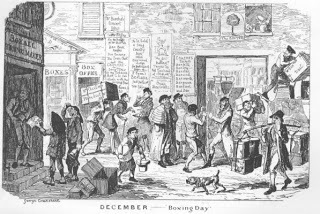
Most of our readers know that it was the practice, not many years ago (and in some places is so still), for families to keep lists of the servants of tradesmen and others, who were considered to have a claim upon them for a Christmas-box at this time. The practice,—besides opening a door to great extortion,—is one, in every way, of considerable annoyance,—and is on the decline. There is, however,—as they who are exposed to it know,—some danger in setting it at defiance, where it is yet in force. One of the most amusing circumstances, arising out of this determination to evade the annoyances of Boxing-day, is related by Sandys. A person in trade had imprudently given directions that he should be denied, on this day, to all applicants for money; and amongst those who presented themselves at his door, on this errand, was, unfortunately, a rather importunate creditor. In the height of his indignation, at being somewhat uncourteously repulsed, he immediately consulted his lawyer; and, having done that, we need scarcely relate the catastrophe. It follows, as a matter of course. A docket was struck against the unsuspecting victim of Christmas-boxophobia.
Boxing-day, however, is still a great day, in London. Upon this anniversary, every street resounds with the clang of hall-door knockers. Rap follows rap, in rapid succession,—the harsh and discordant tones of iron mingling with those of rich and sonorous brass, and giving a degenerate imitation of the brazen clangor of the trumpet which formed the summons to the gate, in days of old,—and which, together with the martial music of the drum, appears to have been adopted, at a later period, by the Christmasboxers, on St. Stephen's-day. Pepys, in his diary (1668), records his having been "called up by drums and trumpets;—these things and boxes," he adds, "have cost me much money, this Christmas, and will do more." Which passage seems to have been in the memory of our facetious publisher, when he made the following entry in his journal of last year,—from whence we have taken the liberty of transcribing it.—"Called out," says Spooner (1834), "by the parish beadle, dustmen, and charity-boys. The postman, street-sweepers, chimney-sweepers, lamp-lighters, and waits, will all be sure to wait upon me. These fellows have cost me much money this Christmas,—and will do more, the next."
There is an amusing account, given by a writer of the querulous class, of a boxing-day, in London, a century ago. "By the time I was up," says he, "my servants could do nothing but run to the door. Inquiring the meaning, I was answered, the people were come for their Christmas-box; this was logic to me; but I found at last that, because I had laid out a great deal of ready-money with my brewer, baker, and other tradesmen, they kindly thought it my duty to present their servants with some money, for the favor of having their goods. This provoked me a little; but being told it was the 'custom,' I complied. These were followed by the watch, beadles, dustmen, and an innumerable tribe; but what vexed me the most was the clerk, who has an extraordinary place, and makes as good an appearance as most tradesmen in the parish; to see him come a-boxing, alias a-begging, I thought was intolerable: however I found it was 'the cus.torn too,' so I gave him half-a-crown; as I was likewise obliged to do the bellman, for breaking my rest for many nights together."
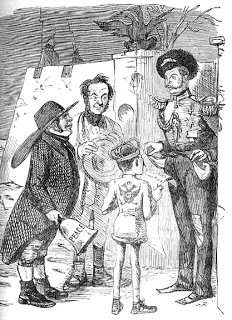
The manner in which the beadle approaches his "good masters and mistresses," for a Christmas-box,—particularly in the villages near the British metropolis,—is, as we have before said, by the presentation of a copy of printed verses, ornamented with wood engravings. These broadsides are usually termed "Bellman's verses;" and we quite agree with Mr. Leigh Hunt in his opinion, that "good bellman's verses will not do at all. There have been," he remarks, "some such things of late ' most tolerable and not to be endured.' We have seen them witty,—which is a great mistake. Warton and Cowper unthinkingly set the way." "The very absurdity of the bellman's verses is only pleasant, nay, only bearable, when we suppose them written by some actual doggrel-poet, in good faith. Mere mediocrity hardly allows us to give our Christmas-box, or to believe it now-a-days in earnest; and the smartness of your cleverest worldly-wise men is felt to be wholly out of place. No, no! give us the good old decrepit bellman's verses, hobbling as their bringer, and taking themselves for something respectable, like his cocked-hat,—or give us none at all."
Upon the bellman's verses which were last year circulated by the beadles of Putney, Chiswick, and other parishes on the west side of London, it was recorded, that they were "first printed in the year 1735;"—and our curiosity induced us to inquire of the printer the number annually consumed. "We used, sir," said he, "not many years ago, to print ten thousand copies, and even more; but now I suppose we don't print above three thousand." Whether the trade of this particular dealer in bellman's verses has passed into other hands,—or whether the encouragement given to the circulation of these broadsides has declined,—the statement of an individual will not of course enable us to determine. But we are inclined to think that,—like other old Christmas customs, —the popularity of bellman's verses is passing away; and that, before many years have elapsed, penny magazines and unstamped newspapers will have completely superseded these relics of the rude, but sincere, piety of our ancestors.
The claims of dustmen to be remembered, upon " Boxing day," were formerly urged, without literary pretensions; but now, "the march of intellect" has rendered it necessary for them to issue their addresses in print. One of these, which lies before us, represents that "the United Association of Dustmen and Scavengers, of the Parish of , have the honor to pay their humble duty and respects to the good [Master or Mistress] of this house, and to solicit a Christmas mark of approbation of their unwearied exertions, which they flatter themselves conduce so eminently to the comfort and salubrity of the greatest metropolitan city of civilized Europe." Here, however, is another,—in which the spirit of St. Stephen's day is embittered by the rivalries of business; and the harmony of those two respectable bodies, the Scavengers and Dustmen, appears to have been disturbed. The dustmen, it will be seen, repudiate the scavengers,—and appeal to St. Stephen, on a separate interest.
"TO THE WORTHY INHABITANTS OF THE SOUTHAMPTON ESTATE."Ladies and Gentlemen,—At this season, when you are pleased to give to laboring men, employed in collecting your dust, a donation, called Christmas-box, advantage of which is often taken by persons assuming the name of Dustmen, obtaining, under false pretences, your bounty, we humbly submit to your consideration, to prevent such imposition, to bestow no gift on any not producing a brass figure of the following description—A Scotch Fifer, french horn, &c., between his legs.—James Dee and Jerry Cane.— Southampton Paving Act—on the bell.—Contractor—Thomas Salisbury. "No connexion with scavengers—Please not to return this bill to any one."
The principal Wait, also, leaves a notice of a more imposing description,—stating a regular appointment to the office, by warrant, and admission,—with all the ancient forms of the City and Liberty of Westminster; and bears a silver-badge and chain, with the arms of that city. We cannot dismiss the various modes of collecting Christmasboxes, without a few words upon the pieces of writing carried about by parish boys; and which, once, presented the only evidence that the schoolmaster was abroad. It appears formerly tohave been the practice, at this season, to hang up in our churches, the work of the most skilful penman in the parish, after it had been generally exhibited; the subject of which was the life of some saint, or other religious legend. Pepys thus mentions the custom :—" 26 December, 1665. Saw some fine writing work and flourishing of Mr. Hore, with one that I knew long ago, an acquaintance of Mr. Tomson's at Westminster, that is this man's clerk. It is the story of the several Archbishops of Canterbury, engrossed on vellum, to hang up in Canterbury cathedral, in tables, in lieu of the old ones, which are almost worn out."
To this usage—which was no doubt of monkish origin,—we are inclined to refer the specimens of caligraphy, upon gaudily ornamented sheets of paper, brought round, on St. Stephen's-day, by parish boys and charity school children, and displayed for admiration and reward. The walls of school-rooms, and of the houses of the children's parents, are afterwards decorated with these "Christmas pieces,"—in the same manner as were anciently the walls of churches.[image error]
Published on December 26, 2011 01:01
December 25, 2011
The Wellington Connection: Christmas
Kristine here, sharing my ornaments with you . . .
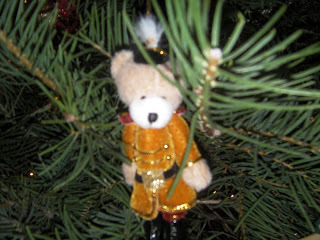
We have lots of bears . . . .
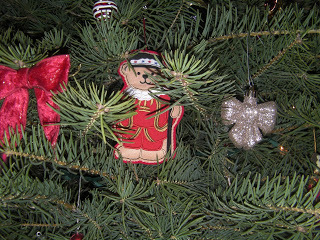

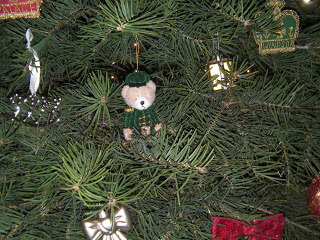
Some birds, calling and otherwise . . .
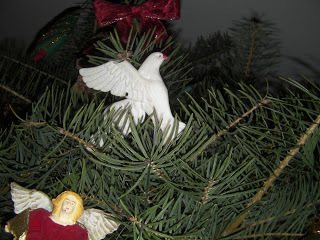
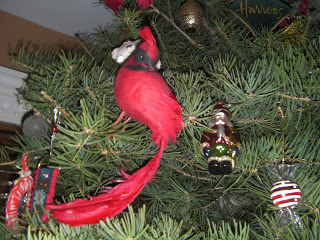
a few souveniers of our travels
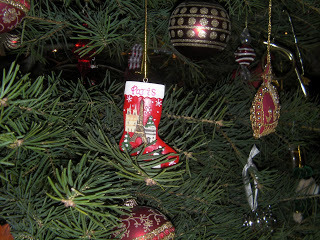
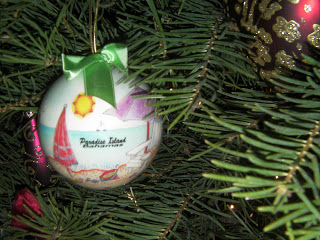
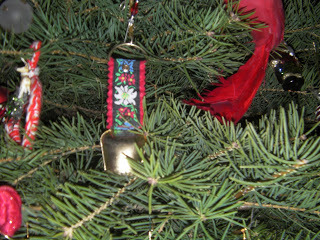
But the majority are British themed baubles, including several Big Bens
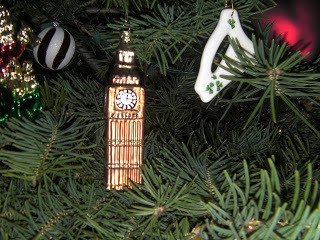
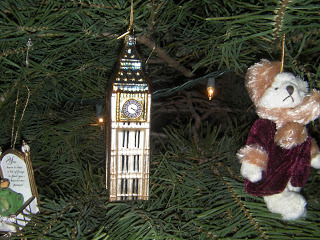
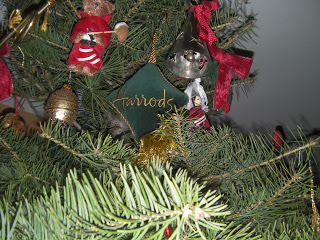
several soldiers . . . .
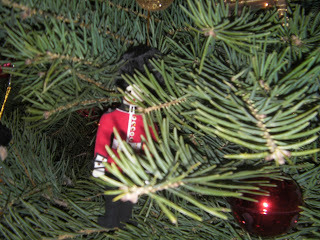
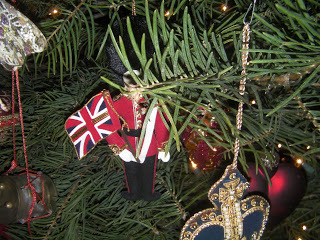
a few Royal personages
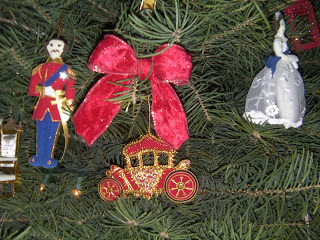
some London icons . . . . .
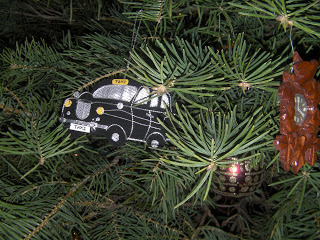
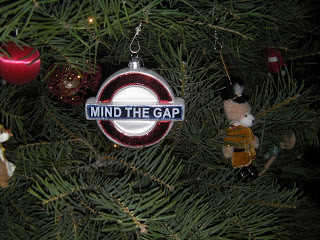
and some thrones for good measure . . . .
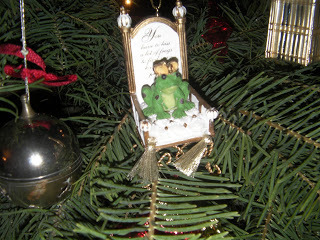
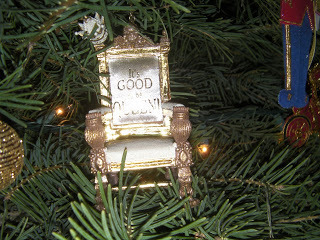
So where, you rightly ask, is the Wellington Connection? Did you think we'd forget the Duke at Christmas!?
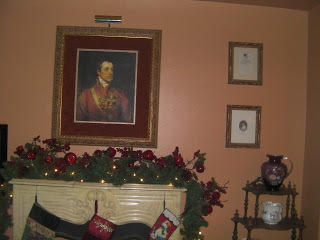
Not a bit of it! The Duke's halls have been decked, and lit, as well.
Merry Christmas!
[image error]

We have lots of bears . . . .



Some birds, calling and otherwise . . .


a few souveniers of our travels



But the majority are British themed baubles, including several Big Bens



several soldiers . . . .


a few Royal personages

some London icons . . . . .


and some thrones for good measure . . . .


So where, you rightly ask, is the Wellington Connection? Did you think we'd forget the Duke at Christmas!?

Not a bit of it! The Duke's halls have been decked, and lit, as well.
Merry Christmas!
[image error]
Published on December 25, 2011 00:45
Kristine Hughes's Blog
- Kristine Hughes's profile
- 6 followers
Kristine Hughes isn't a Goodreads Author
(yet),
but they
do have a blog,
so here are some recent posts imported from
their feed.



